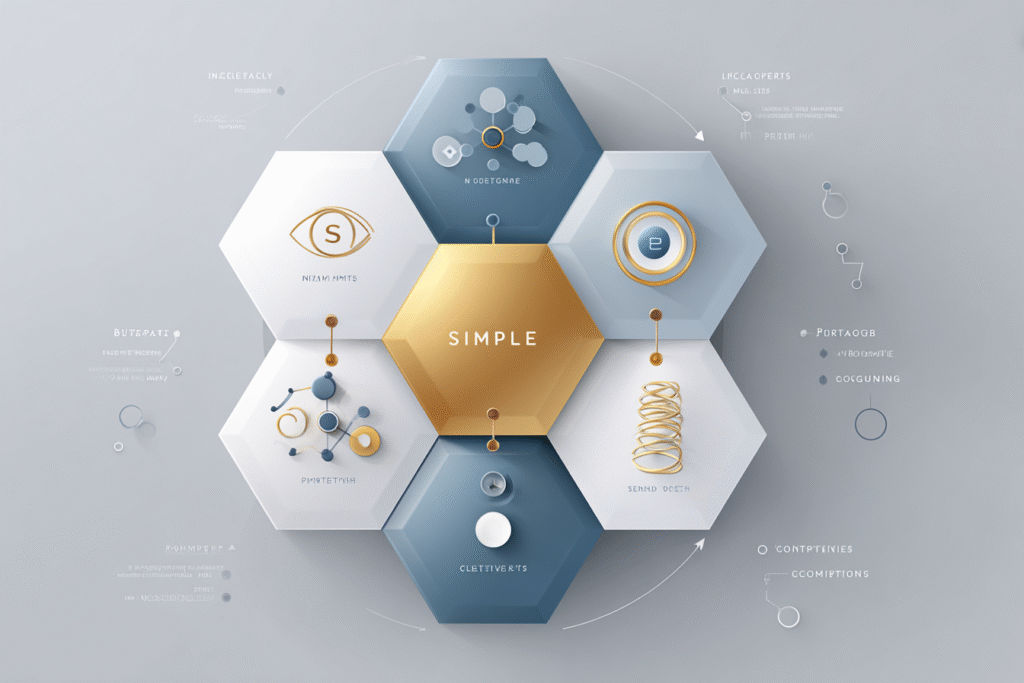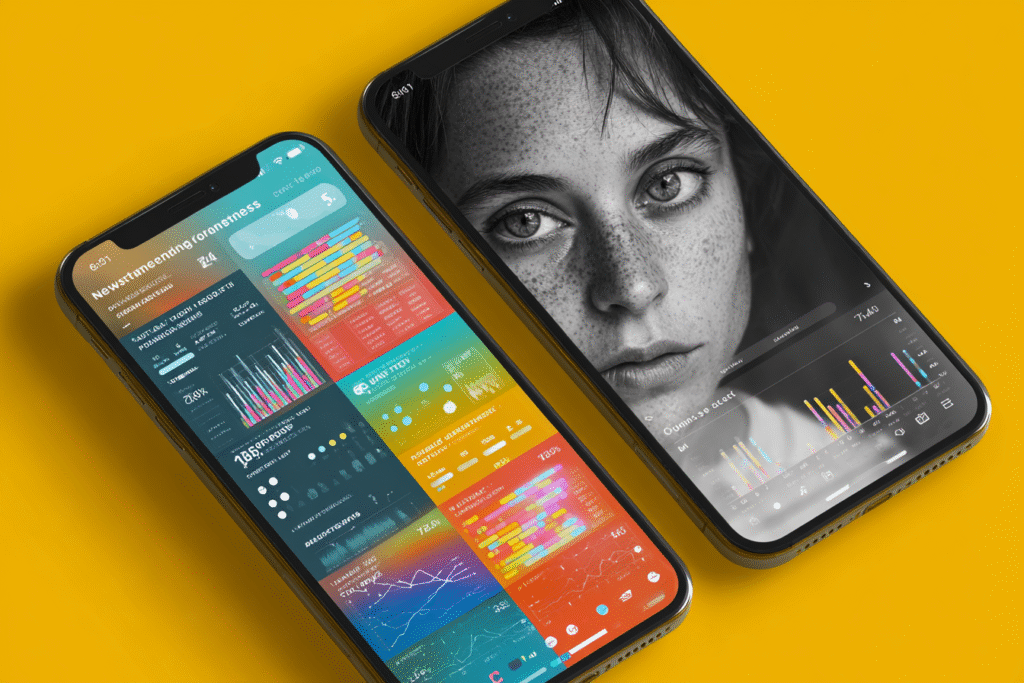Why our tracking obsession gives us the dopamine hit of progress without the actual transformation.
Note: This article is for educational and informational purposes only. See full disclaimer at the end.
You check your phone:
- 12,547 steps.
- 7 hours, 23 minutes of sleep.
- Down 0.3 pounds.
- Blood pressure: 118/76.
- 10 minutes of mindfulness.
You have more health data than any generation in history.
So why don’t you feel healthier?
There’s a gap between what we can easily track and what actually transforms our lives. That gap is the difference between collecting data and generating insights. Between monitoring symptoms and optimizing systems.
In our last article, we explored how systems thinking beats symptom management every time. Today, we’re diving deeper into what happens when we measure the wrong things entirely.
The measurement problem is what happens when we optimize for the visible and quantifiable — instead of the meaningful and foundational.
When Data Becomes the Problem
I discovered this the hard way. With an analytical mind that approaches problems through data, I treated health optimization like debugging code: more information would reveal the solution.

My smartphone became command central for three fitness apps, two sleep trackers, a nutrition logger, a mood tracker, and a habit builder. Every morning, I’d review my heart rate variability, log my supplements, track my macros, and monitor my screen time.
Eighteen months into this data collection project, I sat in my kitchen staring at charts and graphs that looked impressive but meant nothing to my actual health. I had more information about my body than most people in human history, but I didn’t feel any different.
Worse, I felt like I was failing in new ways — overwhelmed by numbers that seemed important but left me anxious, guilty, and disconnected from my own body.
This is the measurement problem in its purest form. I had fallen into what researchers call “measurement myopia” – the tendency to optimize for what’s easily quantifiable rather than what’s genuinely meaningful [2].
The psychology is seductive: numbers feel objective, tracking feels productive, progress bars provide dopamine hits.
But I was about to discover something that would completely transform my approach to health optimization.
The Convenience Trap
My breakthrough came during what I now call my “step count revelation.”
I’d been celebrating hitting 10,000 steps daily for some time when I realized something unsettling: I felt more tired than ever. I was walking in circles around my apartment building at 11 PM just to hit my number.

I was optimizing for a metric that had nothing to do with how I actually felt. This led me to question everything.
Why was I measuring sleep duration when my morning energy had nothing to do with hours slept? Why track heart rate during exercise when my recovery between workouts was what actually determined my training capacity? Why log calories when my energy stability throughout the day was the real indicator of nutritional success?
I was measuring what was convenient, not what was consequential.
The deeper I dug, the more I realized that most health tracking focuses on outcomes – weight, steps, calories – rather than the system inputs that drive real change.
It was like judging a garden by today’s flower count instead of monitoring soil health, water systems, and seasonal cycles.
You might get data, but you’d miss the actual mechanisms of growth.
The Pattern Recognition Breakthrough
My transformation began when I stopped looking at individual metrics and started recognizing patterns.
That shift revealed something profound: the signals were always there — it was my measurement strategy that was getting in the way.
Instead of obsessing over last night’s sleep score, I began noticing how my stress response during the day affected my sleep quality.
For example, I discovered that high-stress Mondays consistently led to restless sleep that affected my decision-making through Wednesday—a three-day cascade I’d never noticed while focused on individual sleep scores. Instead of celebrating daily step counts, I started tracking how my movement choices supported my energy levels throughout the week.
I realized that my 12,000-step days often left me depleted by evening, while my 8,000-step days with intentional movement breaks kept me energized and focused.
I was blindly collecting data points instead of understanding my system. Each metric told me almost nothing. But the patterns between them told me everything.

This insight led me to completely reimagine what measurement could be. Rather than tracking symptoms of health, I started measuring the four foundational systems we explored in the previous article: Sleep Architecture, Stress Response, Nutritional Coherence, and Movement Integration.
With this lens, I re-evaluated everything I was measuring — and began redesigning my metrics from the ground up.
Redesigning My Metrics From the Ground Up
Sleep Architecture Optimization
My old approach: Obsessing over sleep duration from my fitness tracker.
My new approach: Tracking sleep consistency patterns and how well my sleep supported next-day performance. I started asking: “How efficiently are my sleep systems supporting tomorrow’s energy?”
The shift was revelatory. A 6.5-hour night with good sleep hygiene often left me more energized than an 8-hour night filled with stress and screen time.
The duration mattered less than the health of my sleep architecture.
Stress Response Intelligence
I used to monitor my heart rate during exercise, thinking it was a good stress indicator. But the real signal wasn’t the spike — it was how quickly I returned to baseline afterward.
“How efficiently am I recovering?” became the new question.
That shift revealed something unexpected: my afternoon meditation wasn’t just about mindfulness — it was training my nervous system to recover faster, preparing me for evening challenges in ways my workout heart rate couldn’t explain.

Nutritional Coherence
I’d been logging every calorie and tracking my macros down to the gram — but I was missing the bigger picture. My body didn’t care if my lunch was 40% carbs or 30% protein. What mattered was how I felt afterward.
A simple question changed everything: “Does this meal stabilize my energy for the next few hours, or does it make me crash?” That became my new nutritional compass.
The calorie counting had been making me neurotic about food while missing the actual signal: how different meals affected my cognitive performance and energy rhythms. A 400-calorie meal that stabilized my energy for four hours was superior to a perfectly macro-balanced meal that left me crashing two hours later.
Movement Integration
Movement was the last piece to fall into place. I assumed more steps meant better health — but some of my most restorative practices, like evening walks or joint mobility work, barely registered on fitness apps.
The real question became: “Is this movement supporting my life or subtracting from it?”
This led me to discover that my evening walks, which barely registered on fitness trackers, were more valuable for my stress recovery than my intense morning workouts that left me depleted for work.
But knowing what to measure differently was only half the battle. I needed a systematic way to make these measurement decisions consistently.
Without a framework, I risked falling back into the same tracking chaos with different metrics. That’s where SIMPLE became essential.
Keeping Measurement Decisions SIMPLE
The transformation accelerated when I applied the SIMPLE framework to my measurement strategy.

S – See Clearly: Instead of asking “What can I track?” I started asking “What system am I trying to optimize with this measurement?” Most tracking fails because we never clarify the optimization target.
I – Identify Patterns: I focused on metrics that revealed system relationships rather than isolated data points. How did sleep quality affect stress response? How did stress management influence nutritional choices? The connections mattered more than individual numbers.
M – Move with Purpose: Every metric had to connect to a specific system optimization opportunity. If a measurement didn’t guide action, I eliminated it. Data collection without actionable insights was just digital hoarding.
P – Prioritize Systems: Rather than tracking everything, I identified which system optimization would have the greatest cascade effect on others. For me, stress response optimization improved both sleep and nutritional choices.
L – Learn from Outcomes: I measured the relationship between tracking behavior and actual system performance, not just the metrics themselves. Was my measurement approach making me healthier or just more informed?
E – Evolve Continuously: My measurement strategy evolved as my systems improved and my understanding deepened. What helped optimize my systems in month one was different from what I needed in month six.
Technology as System Intelligence, Not Data Collection
Six months into my new approach, my relationship with health technology transformed completely. Instead of using multiple disconnected apps that generated anxiety-inducing daily reports, I focused on integrated platforms that recognized pattern relationships [3].
I went from feeling like a data collector to feeling like a system optimizer.
The technology started working for me instead of against me.
My new technology strategy emphasized context-rich tracking over isolated metrics. Instead of logging individual data points without circumstances, I used systems that connected metrics to stress levels, sleep quality, and life context [4]. A heart rate spike meant something different during a work deadline than during a family celebration.
Most importantly, I shifted from historical reporting to predictive insights. Instead of apps that said “Here’s what happened yesterday,” I prioritized tools that offered “Based on your patterns, here’s how to optimize tomorrow” [5].

The Warning Signs I Learned to Recognize
My journey taught me to recognize when measurement becomes counterproductive.
You know you’ve fallen into the measurement problem when you spend more time logging data than acting on insights, when daily metric fluctuations affect your mood more than actual energy levels, or when you have more health apps than noticeable health improvements.
The measurement addiction is real [8]. The dopamine hit of collecting data can replace the satisfaction of genuine improvement.
I had to learn the difference between feeling productive and actually getting healthier.
My 30-Day Measurement Reset Protocol
Based on my transformation, I developed a systematic approach for anyone trapped in measurement overwhelm [1]:
Week 1: The Audit I listed every health metric I was tracking and asked a simple question for each: “Does this help me optimize a foundational system?” If the answer was no, I eliminated it. This single step reduced my daily tracking from 15 minutes to 3 minutes.
Week 2: System Focus I implemented one measurement for each foundational system, focusing on weekly trends rather than daily fluctuations. Sleep consistency replaced sleep duration. Stress recovery time replaced exercise heart rate. Energy stability replaced calorie counting. Movement quality replaced step counting.
Week 3: Pattern Recognition I looked for relationships between my four system metrics. I discovered that my sleep consistency was the keystone that influenced all other systems. Poor sleep led to stress reactivity, which led to poor food choices, which led to energy crashes that reduced movement quality.
The patterns became impossible to ignore once I started looking for them. When I tracked my stress recovery time alongside my food choices, I noticed that high-protein breakfasts helped me bounce back from morning challenges 40% faster than carb-heavy meals.
When I connected my evening screen time to next-day focus, I found that blue light after 9 PM consistently degraded my cognitive performance for 18-20 hours.
These weren’t just correlations—they were signals my body had been sending all along.
Week 4: System Optimization Armed with pattern insights, I made targeted system improvements. Instead of trying to optimize everything, I focused on sleep consistency for 30 days. The cascade effects improved my stress response, energy stability, and movement integration without direct intervention.
What I’d unknowingly built was a personalized Clarity Loop — one that started with observation, led to pattern recognition, and returned insight back into daily life.

The Transformation Results
Twelve months after abandoning my data collection obsession, my relationship with health had completely transformed. For the first time in years, I felt like I was having a conversation with my body instead of conducting surveillance on it.
My energy became predictable. My stress recovery improved dramatically. My sleep felt genuinely restorative. My movement supported rather than competed with my daily life. Most importantly, I stopped feeling like a health optimization project and started feeling like a person with a well-functioning body.
The paradox was humbling: by measuring less, I understood more. By tracking patterns instead of points, I gained insights that years of data collection had missed.
By focusing on systems instead of symptoms, I achieved the health transformation that had eluded me despite having more health data than any previous generation.
I finally understood the difference between information and wisdom. Information is knowing your heart rate. Wisdom is knowing what your heart rate patterns reveal about your stress recovery system.
The Future of Intelligent Health Measurement
My journey points toward a new paradigm in health tracking – one that emphasizes system intelligence over data accumulation.
We’re moving toward health technology that focuses on pattern recognition across multiple biomarkers, predictive insights based on individual system patterns, and contextual measurement that considers life circumstances [6].
The goal isn’t more data – it’s better insights that lead to genuine system improvement [7]. I discovered that my health systems were already providing signals.
The question was never about gathering more information; it was about measuring the right things and understanding what they actually meant.

Your Measurement Philosophy
The measurement problem is ultimately a philosophy problem. It reveals what we believe matters — and whether we trust our own lived signals more than someone else’s metrics.
Are you collecting data to feel productive, or are you gathering insights to drive transformation?
My experience reveals that when you measure what matters – system inputs rather than outputs, patterns rather than isolated points, insights rather than data – measurement becomes a powerful tool for optimization rather than a source of overwhelm.
Your health systems are already providing signals. The question I learned to ask wasn’t “What can I track?” but “What do I need to understand?” The difference between those two questions is the difference between data collection and system optimization.
It’s the difference between having health information and having health wisdom.
Tomorrow we’ll explore “AI as Your Health Co-Pilot” – how artificial intelligence can amplify your system optimization rather than adding to your data overload.
See you in the next insight.
Comprehensive Medical Disclaimer: The insights, frameworks, and recommendations shared in this article are for educational and informational purposes only. They represent a synthesis of research, technology applications, and personal optimization strategies, not medical advice. Individual health needs vary significantly, and what works for one person may not be appropriate for another. Always consult with qualified healthcare professionals before making any significant changes to your lifestyle, nutrition, exercise routine, supplement regimen, or medical treatments. This content does not replace professional medical diagnosis, treatment, or care. If you have specific health concerns or conditions, seek guidance from licensed healthcare practitioners familiar with your individual circumstances.
References
Cadmus-Bertram, L. A., Marcus, B. H., Patterson, R. E., Parker, B. A., & Morey, B. L. (2015). Randomized trial of a Fitbit-based physical activity intervention for women. American Journal of Preventive Medicine, 49(3), 414-418. https://pubmed.ncbi.nlm.nih.gov/26071863/
Mercer, K., Li, M., Giangregorio, L., Burns, C., & Grindrod, K. (2016). Behavior change techniques present in wearable activity trackers: a critical analysis. JMIR mHealth and uHealth, 4(2), e40. https://mhealth.jmir.org/2016/2/e40/
Cadmus-Bertram, L., Marcus, B. H., Patterson, R. E., Parker, B. A., & Morey, B. L. (2015). Use of the Fitbit to measure adherence to a physical activity intervention among overweight or obese, postmenopausal women: self-monitoring trajectory during 16 weeks. JMIR mHealth and uHealth, 3(4), e96. https://mhealth.jmir.org/2015/4/e96/
Michie, S., Richardson, M., Johnston, M., Abraham, C., Francis, J., Hardeman, W., Eccles, M. P., Cane, J., & Wood, C. E. (2013). The behavior change technique taxonomy (v1) of 93 hierarchically clustered techniques: building an international consensus for the reporting of behavior change interventions. Annals of Behavioral Medicine, 46(1), 81-95. https://pubmed.ncbi.nlm.nih.gov/23512568/
Shcherbina, A., Mattsson, C. M., Waggott, D., Salisbury, H., Christle, J. W., Hastie, T., Wheeler, M. T., & Ashley, E. A. (2017). Accuracy in wrist-worn, sensor-based measurements of heart rate and energy expenditure in a diverse cohort. Journal of Personalized Medicine, 7(2), 3. https://www.mdpi.com/2075-4426/7/2/3
Nelson, B. W., Allen, N. B., Scigliano, J., Wolff, E. S., Obuya, B., Fleming, K. N., Manganello, J. A., Carnevale, L., Santangelo, P. S., Kunkels, Y. K., Banaschewski, T., Millenet, S., Bokde, A. L., Flor, H., Grigis, A., Garavan, H., Heinz, A., Brühl, R., Martinot, J. L., … IMAGEN Consortium. (2020). Guidelines for wrist-worn consumer wearable assessment of heart rate in biobehavioral research. npj Digital Medicine, 3, 90. https://pubmed.ncbi.nlm.nih.gov/32613074/
Piwek, L., Ellis, D. A., Andrews, S., & Joinson, A. (2016). The rise of consumer health wearables: promises and barriers. PLoS Medicine, 13(2), e1001953. https://pubmed.ncbi.nlm.nih.gov/26836780/
Gouveia, R., Karapanos, E., & Hassenzahl, M. (2015). The relationship between self-tracking experiences and well-being. In Proceedings of the 33rd Annual ACM Conference Extended Abstracts on Human Factors in Computing Systems (pp. 1851-1856). https://dl.acm.org/doi/10.1145/2702613.2732771


